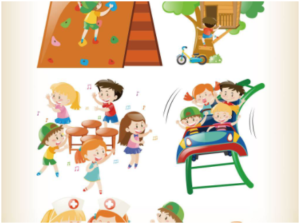
01 Before Kindergarten Opens
After the opening of the nursery,
03 Emergency Treatment of Suspected Infection Symptoms
01
Before the kindergarten opens,
Formulate the epidemic prevention and control work plan of the park, including the epidemic prevention and control work leading group, the work responsibility system of each post (the first responsible person, each department, each class, each teacher), the epidemic prevention and control work process, the information reporting process, the parent communication mechanism, the emergency response plan, etc. The system is clear, the responsibility is assigned to the person, and training and drills are conducted. The main person in charge of nurseries and kindergartens is the first person in charge of epidemic prevention and control in this unit.
Understand the health status of teaching staff and children on a daily basis, implement the system of “daily report” and “zero report”, and report the specific situation to the competent department every day according to the prevention and control requirements.
According to the requirements of the higher authorities and the latest version of novel coronavirus pneumonia’s prevention and control plan, all teaching staff will be trained in system, knowledge and skills.
- Before opening the park, sanitary cleaning and preventive disinfection shall be carried out on the park.
- All teaching staff and children who go out should be isolated at home for 14 days after returning to their place of residence, and the healthy can only enter the park.
Preventive disinfection: Disinfection of articles and places that may be contaminated by pathogenic microorganisms when there is no clear source of infection.
- Do a good job in the storage of relevant materials for prevention and control work, and prepare sufficient hand sanitizer, hand disinfectant, mask, gloves, alcohol, disinfectant, thermometer, vomiting bag, ultraviolet disinfection lamp, etc.
- Set up (temporary) isolation rooms, which are relatively independent in location, in case of fever and other conditions for immediate isolation.
02
After the kindergarten opens,
Know the health status of teaching staff and children every day, implement the “daily report” and “zero report” systems, and report the specific situation to the competent department every day according to the prevention and control requirements.
Strengthen ventilation for all kinds of living, studying and working places (such as activity rooms, sleeping rooms, washrooms, teachers’ offices, music rooms, washrooms, etc.), with ventilation not less than 3 times a day and not less than 30 minutes each time.
- Daily disinfection of the park.
- Facilities on the ground and in public areas can be wiped with chlorine-containing disinfectant (available chlorine 250mg/L-500mg/L), and wiped with clear water after 30 minutes of action.
- Public class places (such as music rooms, dance rooms, activity rooms, etc.) must be disinfected before each group of students enter.
Accurate disinfection: indoor object surface, ground, outdoor large toys, fitness equipment, and ground with obvious pollutants (decontamination before disinfection). The air in the outdoor environment does not need disinfection, and the ground and green plants rarely touched outdoors do not need disinfection.
- Strengthen the surface cleaning and disinfection of objects, and regularly disinfect and record them every day. The high-frequency contact surfaces such as door handles, faucets, stair handrails and bed fences can be wiped with chlorine-containing disinfectant with available chlorine of 250 ~ 500mg/L.
Routine disinfection of children’s dining table before “three meals and two o’clock” every day.
- To strengthen the cleaning and disinfection of food (drinking) utensils, food (drinking) utensils should be disinfected one by one.
- Remove residues from food (drinking) utensils, after cleaning, boil or circulate steam for disinfection for 15 minutes; Or use thermal disinfection cabinet and other disinfection methods; Or soak in chlorine-containing disinfectant with available chlorine 250mg/L for 30 minutes, and wash away the residual disinfectant after disinfection.
Boiling disinfection: completely immerse the articles to be disinfected in water, heat and disinfect, and calculate the disinfection time from when the water boils. Circulating steam method: Put the articles to be disinfected into a steam drawer, heat and disinfect, and calculate the disinfection time from when the water boils to generate steam.
Disinfectant soaking disinfection: completely immerse the articles to be disinfected in disinfectant.
Tableware disinfection cabinet: conforms to relevant national hygiene standards. The temperature in the thermal disinfection cabinet must be ≥ 100 ℃ for 15min.
Sanitary ware can be soaked, wiped and disinfected with 500mg/L chlorine-containing disinfectant. After 30 minutes of action, rinse with clear water and dry for later use.
Attention: wash table top, faucet, inside and outside toilet bowl and its cushion and button, toilet squatting pit, ground.
Strengthen the classified management of garbage, collect and remove it in time, and clean the garbage container. Chlorine-containing disinfectant with available chlorine 500mg/L can be used to disinfect it regularly.
Teachers are advised to wear medical masks when teaching.
Teachers, staff and children take their body temperature every day when they enter the park, and strictly implement the system of morning, afternoon, evening and full-day observation for children.
During the morning examination, the staff should wear masks and disposable gloves.
Strictly implement hand hygiene measures for teaching staff and children. Children must wash their hands in the following situations: after entering the park, before eating, before and after going to the toilet, entering the room from the outdoors, after contacting stains, after blowing their noses, after sneezing, after covering their nose and mouth with their hands, after soiling their hands, etc.
- Strict implementation of the parents to transport children not into the park system.
- Strengthen the management of absence due to illness. Make records of absenteeism, early departure and medical leave, and timely follow-up, registration and reporting of teaching staff and children found to be absent due to illness.
It is not suitable to organize large-scale collective activities.
- Through various forms of publicity and education on novel coronavirus pneumonia prevention for teaching staff, children and parents.
- Teach children the correct way to wash their hands, train children to develop good hygiene habits, and cover their nose and mouth with paper towels and sleeves when coughing or sneezing.
- To guide parents not to take their children to densely populated and enclosed places during the epidemic prevention and control period.
03
Emergency Treatment for Suspected Infection Symptoms
The teaching staff suffered from fever, dry cough, fatigue and other symptoms, and were instructed to wear masks to go to the fever clinic within their jurisdiction immediately.
If a child suffers from fever, dry cough, fatigue and other symptoms, he or she shall immediately use the (temporary) isolation room to take effective isolation measures for the child. At the same time, he or she shall notify the parents to bring the child back, take the child to the medical institutions within his or her jurisdiction with pediatric fever clinics, and take good protection.
Health risks shall be informed to the general contacts living and studying together, such as respiratory symptoms such as fever and dry cough, diarrhea, conjunctival congestion and other symptoms, and timely medical treatment shall be required.
Assign special personnel to contact the parents of the quarantined teaching staff or children to understand the daily health status of the teaching staff or children.
Fight against the epidemic, start with me!
Source: Jiangsu Center for Disease Control and Prevention
